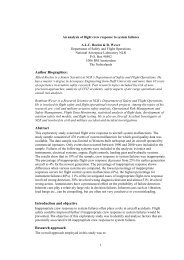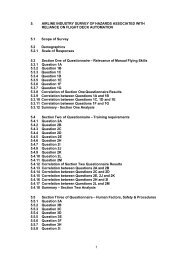Causal risk models of air transport - NLR-ATSI
Causal risk models of air transport - NLR-ATSI
Causal risk models of air transport - NLR-ATSI
Create successful ePaper yourself
Turn your PDF publications into a flip-book with our unique Google optimized e-Paper software.
caused by overrotation and subsequent wing stall. These problems were solved by a<br />
modified wing leading edge. Regulation was also changed as a result <strong>of</strong> these accidents,<br />
requiring demonstration <strong>of</strong> a minimum unstick speed with maximum angle <strong>of</strong> attack.<br />
[EASA 2003a]. But then in 1954 a Comet disintegrated while climbing to its cruising<br />
altitude, and the British Overseas Airways Corporation BOAC grounded its fleet <strong>of</strong> jet<br />
<strong>air</strong>craft. However, no defects were found and the <strong>air</strong>craft were put back into service.<br />
Sixteen days later, another Comet broke-up in mid-<strong>air</strong>, and the <strong>air</strong>craft’s Certificate <strong>of</strong><br />
Airworthiness was suspended. After extensive testing, it was discovered that the accidents<br />
had been caused by fatigue cracking <strong>of</strong> the fuselage skin. This was a new phenomenon, first<br />
encountered by the Comet because its high cruise altitude resulted in relatively large stress<br />
cycles to the fuselage (pressure cabin) skin. Production <strong>of</strong> the Comet was halted. A<br />
modified version, the Comet 4, flew in 1958 but by that time competing <strong>air</strong>craft were on the<br />
market and the Comet 4 was not a commercial success.<br />
As a result <strong>of</strong> these developments, <strong>air</strong> travel today is astonishingly safe. For <strong>air</strong> carriers in<br />
Europe or the US, the fatal accident rate per million flights is approximately 0.2 [CAA-NL<br />
2007]. If a person were to take a flight each day, he would, on average, experience a fatal<br />
accident after 13,700 years. Even then, the likelihood <strong>of</strong> being killed in that accident is less<br />
than the probability <strong>of</strong> survival; an analysis <strong>of</strong> fatal accidents by US domestic <strong>air</strong>lines in<br />
1987-1996 showed that, on average, a fatal accident kills 44% <strong>of</strong> the occupants <strong>of</strong> the<br />
<strong>air</strong>craft [Barnett & Wang 2000]. A fatal accident is defined as an event in which at least one<br />
<strong>of</strong> the occupants is killed, so even in the case <strong>of</strong> a fatal accident the majority <strong>of</strong> the<br />
occupants may survive. Does this mean that a sufficient level <strong>of</strong> safety has been reached?<br />
Certainly not from the viewpoint <strong>of</strong> the regulator. Aircraft accidents cost lives and are a<br />
cause <strong>of</strong> emotional trauma to victims’ relatives and friends, to people working within the<br />
industry, to communities. Crashes consume the attention <strong>of</strong> the media in a unique way; any<br />
fatal <strong>air</strong>line crash will always be a headline story. As a result, it is feared, the general public<br />
may loose confidence in the <strong>air</strong> <strong>transport</strong> system. The extent to which ‘<strong>air</strong> crashes’ are<br />
reported in the media has always been <strong>of</strong> concern to the industry and has been seen as a<br />
possible limiting factor to growth for at least 60 years. In 1943, a confidential ‘report’<br />
produced by the Curtis Wright Corporation on behalf <strong>of</strong> the US Government stated that if<br />
<strong>air</strong> safety did not improve from the level achieved during the 1930s, the rapid expansion in<br />
<strong>air</strong> travel expected after the war would result in an unacceptable level <strong>of</strong> <strong>air</strong> crashes and<br />
would limit growth. These views have been repeated many times over the years, for<br />
instance by the US Secretary <strong>of</strong> Transport at the Aviation Safety Conference in Washington<br />
D.C. in 1995 [FAA 1995b] and are still regularly voiced today. Perceived public demand<br />
for safe <strong>air</strong> travel is counterbalanced by a demand from within the industry to remain<br />
pr<strong>of</strong>itable. As early as 1959, Walter Tye (UK ARB – Air Registration Board) suggested<br />
that an optimum balance may have been achieved between <strong>air</strong>line flight safety and costs.<br />
He argued that any further marked increase in safety by (then) existing methods would cost<br />
far more than passengers or the industry would be willing or able to pay (as quoted in<br />
[Bland 1962]). This view was repeated, at the 1961 FSF Seminar, by M.G. Beard,<br />
American Airlines, who said he believed that the major <strong>air</strong>lines had already reached a<br />
position <strong>of</strong> ‘diminishing returns’ in that they had (in 1961) reached a very high degree <strong>of</strong><br />
safety and further improvements would cost more and more. However, the costs associated<br />
with an accident can also be enormous, and while much <strong>of</strong> this is absorbed by insurance,<br />
the effect <strong>of</strong> an accident on the <strong>air</strong>line’s stock price and ticket sales is uninsured. Some<br />
<strong>air</strong>lines have actually gone bankrupt after an accident, examples are Birgen<strong>air</strong> 24 and Helios<br />
24<br />
On February 6, 1996 a Birgen<strong>air</strong> Boeing 757 crashed shortly after take-<strong>of</strong>f from Puerto<br />
Plata in the Dominican Republic, killing all 189 occupants. Birgen<strong>air</strong> was a Turkish holiday<br />
39




